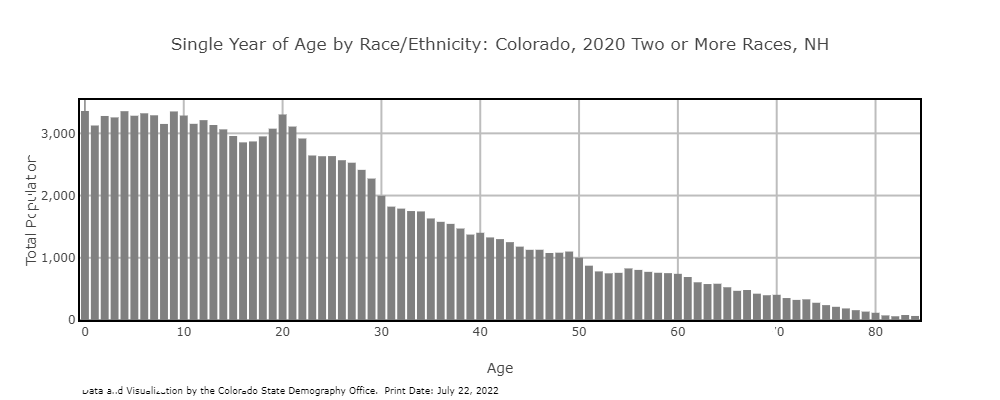
New SDO Race and Hispanic Origin Data Series
The publication of 2020 Census data has changed the way that Race and Hispanic Origin categories are represented. The Census Bureau has worked hard to expand the information to code responses to the Race and Hispanic Origin questions on the Census form. These changes resulted in an increase in the number of persons classifying themselves as “multi-racial”, i.e., the number of people who identify with more than one Race
See the Census Bureau 2020 Race and Ethnicity Dashboard
The State Demography Office publishes Colorado estimates of race and ethnic groups by sex and age and produced a new data series reflecting the categories used by the Census Bureau. These revisions require a break in the data series, meaning that the categories used in the 2010-2020 data series (a series benchmarked to the 2010 Census) are not fully comparable with the categories benchmarked to the 2020 Census. Two notable changes are the separation of the “Native Hawaiian/Pacific Islander” and "Asian" categories from the “Asian/Pacific Islander" category and the addition of a “Two or More Races” category in the data tools and spreadsheets published on the State Demography Office website.
See the Census Bureau’s discussion of these coding changes
The major changes in the 2020 Decennial Census data are grounded in questionnaire and data processing changes. For example, the 2020 Decennial Census form allowed for an open-ended response box for each racial and Hispanic Origin category. This allowed respondents to enter information about their ancestry. Unlike previous Census processing, the Census Bureau has taken additional effort to recover and code these open-ended responses to create a more accurate tabulation of respondents’ Race and Hispanic Origin.
The addition of the new racial categories and the changes in processing limit the comparability of the 2020 Census data with previous data series. This means that Colorado’s current population estimate series, which is based on the 2020 Decennial Census data, should not be compared to previous estimate series, which have been based on the 2010 and earlier censuses. While SDO will continue to update our estimate series annually, some of the differences between the 2020 and 2021 estimates and previous estimates, such as the 2019 and 2020 estimate based on the 2010 Census, will reflect differences in the processing of the 2020 Census and not necessarily reflect changes in the population.
Accessing Race and Ethnicity Data
The most current estimates by Race, Hispanic Origin, sex, and single year of age based on the 2020 Census are available for the State, Regions, and Counties in data spreadsheets optimized for incorporation in a database or a statistical analysis program. We are also providing access to estimate data for 2020 to the present by Race, Hispanic Origin and single year of age in the Race by Age application and 2020 State, Regional, and County lookup applications.
The 2010-2020 data series, based on the 2010 Census, is still available to users who need historical data by providing 2010-2020 data records by Race, ethnicity and single year of age in a spreadsheet and by providing links to the 2010-2020 State, Regional, and County lookup applications.
Please contact the SDO team if you have any questions about the population of Colorado.